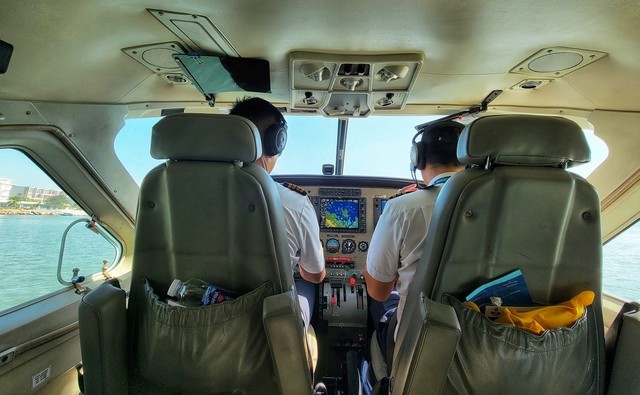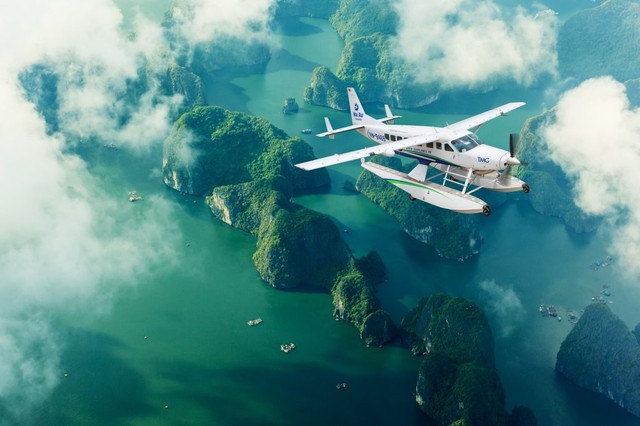In August 2014, two seaplanes of Hai Au Airlines (part of the Thien Minh Group) landed at Noi Bai Airport after a 15,000 km journey across the Pacific Ocean, marking the first time this type of aircraft has been put into service in Vietnam. With both wheels and pontoons installed under the aircraft, seaplanes can land on both airport runways and water surfaces such as the sea, rivers, and lakes.
These are 2 out of 3 seaplanes ordered by Hai Au from the Cessna Group in the US, belonging to the Cessna Grand Caravan 208B-EX series with a price of about 3.2 million USD per plane. The aircraft has 2 seats for the pilot, 12 seats for passengers, and wide windows for viewing scenery from 150 to 2,000 meters above sea level.
Although bringing a unique and promising new tourism product that attracts both domestic and international tourists, the seaplane service is considered a “gamble” by Thien Minh – a “prestigious” business in the tourism industry. Besides the considerable investment costs, the ticket price of 5 million VND (about 218 USD) per person for a 25-minute sightseeing tour on Ha Long Bay also seems to be a barrier for domestic tourists. An insurmountable problem that cannot be ignored is the complications in the procedures for seaplanes.
However, 10 years since takeoff, Hai Au has still maintained an average annual growth rate of 15-20% in passengers and revenue, while increasing the proportion of domestic passengers from 10% to 30% after the Covid-19 turning point.
Focusing on Ha Long Bay, overcoming the “storm” of Covid-19
Compared to the early days of establishment, Hai Au still maintains a fleet of 3 Cessna 208 seaplanes and plans to research and operate electric-powered aircraft to keep up with the world’s “green” fuel trend. The 3 types of services currently being deployed are sightseeing flights (about 25 minutes), scheduled flights (on certain fixed routes), and charter flights (referred to as “taxi” flights).
For the tourism industry in general, Covid-19 is a heavy blow due to a series of distancing measures, travel restrictions, and border controls of countries. Specifically for Hai Au, the impact is particularly strong because before the pandemic, international tourists accounted for 90% of the total passengers served by the airline. The outbreak caused a complete loss of this customer source.

Inside the seaplane of Hai Au Airlines.
“Like other businesses in the aviation and tourism industry, Hai Au encountered many difficulties and had to suspend operations from February to April 2020. At that time, we realized that the domestic market was the only lifeline, so we implemented a series of marketing and promotion measures, collaborated with partners with strengths in the domestic market, and adjusted ticket prices to be more affordable for the Vietnamese people. As a result, we resumed operations from May 2020,” said a representative of Hai Au Airlines.
According to the information on Hai Au’s website currently, the ticket price for a 25-minute sightseeing tour on Ha Long Bay is 2 million VND (about 87 USD) per person. The airline’s representative said that during the Covid-19 period, Hai Au was one of the few travel companies in Quang Ninh that maintained regular operations with 100% domestic customers, proving the attractiveness of the experience.
“In the summer of 2021, there were days when we flew up to 15 sightseeing flights exclusively serving Vietnamese tourists. Thanks to timely switching to the domestic customer source, Hai Au remained resilient during the Covid-19 period with revenue growth. We did not lay off any employees and did not have any outstanding financial obligations to any suppliers,” the representative affirmed.
Hai Au’s orientation is to develop tourism products in the Hanoi and Quang Ninh areas, with a focus on the World Natural Heritage site Ha Long Bay. The airline’s average annual passenger and revenue growth rate is 15-20%. In 2023, the number of passengers experiencing Hai Au’s flights will reach over 10,000 trips.
With the strategy of attracting domestic passengers in the 2020-2023 period and recovering international customers from mid-2023 to the present, Hai Au’s current passenger ratio is 70% international and 30% domestic. In 2023, the airline opened a new route to Co To Island and is also considering the possibility of opening a route to another island in the region – Quan Lan.
Hai Au is currently a partner of many large travel companies in the domestic market such as Vietravel and Saigon Tourist, 4-5-star hotels and resorts such as Novotel, Metropole, Vinpearl, as well as cruise companies. The goal is to offer a complete travel solution with unique experiences for tourists.
Infrastructure and management mechanism difficulties: The “egg or the chicken” story
Assessing the potential for developing seaplane services in Vietnam, a representative of Hai Au Airlines pointed out that the country has a long coastline and a diverse system of rivers and lakes, creating favorable conditions for deploying 2 types of combined aviation and tourism services using seaplanes: short-haul transportation between localities and sightseeing experiences.

“Imagine seaplane flights from Noi Bai to Ba Be Lake, Ha Long Bay, or taking off from the Saigon River and landing at the Hau River, Can Tho City. For us, tourist centers like Nha Trang Bay and Phu Quoc Island have great potential for developing seaplane tourism products. A global example is the Maldives, where all tourists fly by seaplane to resorts on the island.
One point we need to emphasize is the “water airports” where seaplanes land and take off is a “natural infrastructure” bestowed by nature. We almost don’t need to invest anything extra in infrastructure and can start operating right away,” the representative analyzed.
However, the question is why until now, Hai Au is still the sole player in the market without any other seaplane airlines in Vietnam?
In response to this question, the representative said that investing in aviation has never been an easy task, especially in the aviation industry in general – including seaplanes. Beyond the problems of products, customers, and revenue, airlines have to allocate a considerable amount of expenses to ensure aviation safety standards – the most important factor in the industry’s operations. According to the representative, this factor requires caution from any company participating in the industry.
“On the other hand, the seaplane sector and the aviation industry in Vietnam in general face difficulties in terms of infrastructure and specialized management mechanisms. For example, we do not have a dedicated airport network plan. Seaplane airlines like Hai Au have to request approval for each airport and route when they want to expand their operations.
This process is difficult and time-consuming. This is the “egg or the chicken” story, whether infrastructure comes first or the demand for general aviation comes first. In our opinion, this field requires the development vision of the specialized state management agency,” the Hai Au representative highlighted.















